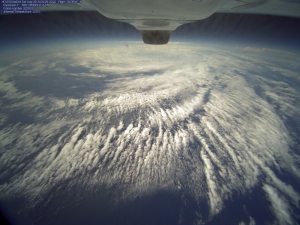HRD scientist Michael Black and NASA scientist Gerry Heymsfield helped conduct a first ever high-altitude flyover of Tropical Storm Frank with the NASA Global Hawk unmanned aerial system (UAS). The Global Hawk flew a 13-hour mission from Edwards AFB, California to the Eastern Pacific basin to fly the low pressure system that was Hurricane Frank a couple of days before. NOAA and NASA shared the mission scientist’s role to coordinate with and advise the Global Hawk pilots (one of whom is a NOAA Corps officer) of real-time aircraft track changes and conditions that could be expected at an altitude of about 60,000 feet. The mission scientists used a combination of NOAA and NASA real-time satellite products, superimposed with current, past, and future positions of the aircraft, to decide where the aircraft should head to obtain the best possible data without placing the plane at risk of turbulence or other adverse conditions. All of the remote sensing instruments performed well on the aircraft, including a high–definition camera that was useful for identifying targets and provides imagery of detailed cloud structures in a wide swath ahead of and beneath the Global Hawk. The first image shows the clouds swirling around Tropical Storm Frank as seen by the high-definition camera when the Global Hawk approached the storm at 60,000 feet from the south. The second image shows the cloud field around Frank in a visible satellite image near the same time (credit Naval Research Laboratory, Monterey, CA, NOAA, and NASA).
NOAA is also collaborating with NCAR and NASA to develop and test a GPS dropsonde system for the Global Hawk to use in tropical cyclone monitoring. The new dropsonde system will be flown in future tropical cyclones.
Based on this first experience in a weak tropical system, NOAA and NASA are confident that the Global Hawk is ready to pursue more formidable targets, probably beginning with Hurricane Earl in the Atlantic this week. For more details see full article at:
http://www.aoml.noaa.gov/spotlight/NOAA-NASA%20Global%20Hawk.pdf

